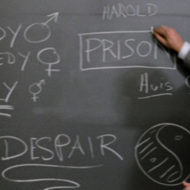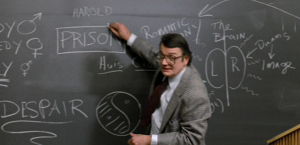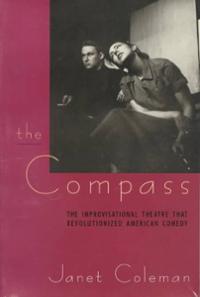Know before you go!
HOW TO DO SCENES:
Make eye contact, in scenes, and when on the back line. Watch the scenes in front of you. Don’t ever look down. Looking down equals thinking. Look at others on the back line. Listen for all kinds of unspoken communication.
Act and React
“Yes and” means “agree to and add to the reality.”
Follow the fear…take an action even if it feels uncomfortable
Give and take means drive and follow. Alternate between these.
Be in an environment. Know where you are. Just decide where it is and share.
Give yourself an activity… Gets you out of your head. Don’t talk about the activity. Talk about something else.
Avoid, if you can, conflict, questions, transactions, teaching, laying it all out. If it happens, “yes and” it and take any opportunity to resolve conflict, answer the question, focus on your relationship instead.
First thing is the most important thing, stay there. Go back to it. Like a drummer counts off the beat, keep playing the same song. Repeating the patterns is more interesting than being endlessly inventive.
When in doubt, confess. Use “I” or “you” statements. Share the secret if you feel like you have a secret or your partner has a secret.
Give yourself a character or physicality or emotion. Anything just slightly outside of you will make you feel more free. “Wear your character like a loose garment.”
The scene is already there. Just discover it, explore it, heighten it (mood, stakes.) You are already there and already know the right thing to do or say, just the way you would in life. Know that only YOU could do this scene the way you are doing it. Laughs come from when you do or something that audience knows is REAL.
When some reality has been established, ridiculous or mundane, ask, if this is true, what else could be true?
Don’t be afraid of silence, especially if change of tone is needed.
Don’t be afraid of mistakes. There are none. Everything happens for reason or is given a reason so relax and trust it and your partners.
Have fun.
HAROLD:
A thing called “harold” is the basis for most of what everyone does in longform improv. Harold is used to describe a 3-beat structural framework around which a group can improvise. It is usually taught as a training device to get people to know what longform improv feels like, pretty quickly. Then people can stretch out from that structure to do what is called for in any given moment. Del Close also used the word “harold” more broadly, as a philosophical idea that guides us to create improvise scenes and structures, and even a spirit that maybe shows up if we are doing things right and with all of our heart.
Here is a brief description of the structure and also some of the spiritual stuff, so we can start to share the vocabulary.
This is stuff I learned from Del Close and ImprovOlympic, mixed in with my own stuff and the stuff I learned from many amazing teachers and performers over two decades. No idea where stuff began and where it will go. Feel free to take it with you.
The Training-wheels Harold (the “1-2-3 Kick” -Del) Harold)
Group Opening
Helps create a group mind and connections
Serves as a sort of musical or thematic overture to the whole piece
Generates information about the suggestion. You remember images, vivid monologues, and patterns that repeat. Can be looked at as deconstructing the suggestion, breaking it apart into all of its many aspects, and investing it with personal meaning. The opening may just touch on the high notes of these meanings, to be further explored in the scenes and group games. Keep it short.
Beat One- scenes 1, 2, 3
Should be as far as away as possible from one another. When scenes start to come together towards the end, they have had a more satisfying journey.
Minimal interference from outside players in this first set of scenes (walk-ons, split scenes, swinging doors, scene narration, etc.)
Should not be about the suggestion, but about themes or characters or games suggested by the opening.
First Group Game
Can be more directly about the suggestion, involving more players, and can either be discovered organically or can be shaped by a strong initiation.
Second Beats of each scene
Heightens the scene from the first beats either thematically, emotionally, or temporally. You can launch into further exploration of the game of the first scene with new characters (if it was a very strong game that can be easily identified), or use the same character or characters and initiate another time (future or past) or place (or situation). Avoid story and focus on relationships. Time dash over plot so we encounter the same characters again and explore them fresh. There are no set rules as to what the second beat should be, just be aware of making connections, making discoveries, and repeating patterns.
Second Group Game
Same as the first, only better.
Third Beats of each scene
Quick revisitation of earlier scenes. The game of the scenes, and/or the characters should have been developed well enough by now to be able to hit the heart of the relationship much more quickly. The final three scenes should also start to discover connections to the other scenes, and some mixing and weaving of characters, themes, and locations should occur. This might take the place of or evolve into the Final Group Game.
Final Group game
Ideally the final group game is organic, informed by everything that has happened for the last half hour or more. It is an opportunity to tie together loose ends and create a sense of closure. It is usually unnecessary, especially if in the last beat the scenes started merging. If possible, shoot for a big finish, like the rack that is fired off at the end of a fireworks display. Arty abstraction is also a cool way to end. Or end with everyone dying.
Other Elements of Harold
Monologues:
Monologues are the whippets of Harold: quick, inspired, inspiring moments of individual clarity. They can be opinions, memory images, a quick story, a fact, or a song. They occur during the opening and at any point throughout the Harold. A group game can be entirely monologues. If you are inspired to do a monologue, step out front and commit to it. A monologue can clearly edit/end a scene, or it can be in the middle of a scene, at which point the players freeze and then continue the scene as if there was no break. They should not comment directly on the monologue, but just listen to it and allow it to enter the group consciousness. It will be integrated in subtler ways if you don’t let it immediately affect the scene.
Edits
are intuitive, after a while you can hear the beats
when there is a peak in energy
when the game or action is coming full circle
after a big laugh
When there is agreement on future action or location
When there is a strong statement of a thesis, belief, a resolution
Don’t ever practice preventative editing. Trust that a scene will find its natural edit and don’t edit too soon just because you think a scene is dying.
Be prepared to take the stage after an edit, even if it’s not your turn. Mix it up. You can sweep, but in general discoveries require more than one player, so try not to leave players alone on stage. The stage should never ever be empty.
Experiment incorporating “thematic” edits. If the suggestion was “water” try editing with the sound and movement of water, or edit with a memorable sound or movement from the opening.
Loosening of structure
The above is the training wheel Harold. Feel free to loosen the structure by mixing up characters and the order when you feel strong and comfortable, or when Harold calls for it. Don’t be afraid to go out with no idea, and be prepared to play with any person, or character, with whom you might find yourself on stage. Trust in discovery, and ye shall be rewarded.
Be aware of levels- of varying and stretching the emotional levels and energy levels. Structure comes organically when you learn to listen to levels like you would listen to or create music–time for a quiet section, time for chaos, time for a rapid-fire succession of scenes or walk-ons. Don’t be afraid of the silences, there can be just as much power in a silence as there is in screaming. Too much screaming or too much silence becomes boring.
Long-form improv thrives on slow comedy, listening, honesty, support, agreement, and intelligence. There are no mistakes because you weave mistakes into strengths by justification. Your primary job is to make your stage partner look good, and listen carefully to every thing that transpires. Connections then occur organically.
Practice Yes And, abandon yourself to the good of the whole, turn the other cheek, give gifts, and try to truly love each other. But only while on stage. To commit too rigidly to these tenets in real life, Del would say, would be insanity.
I’ll post some books here soon. Kevin Mullaney’s Improv Resource Center is also a good place to explore.
This is Del: “What does it MEEEAAAANNN.”
This is the book that got me interested in improv:


